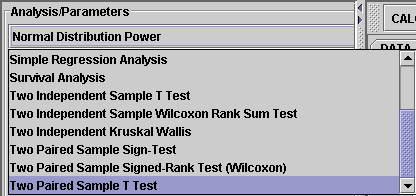Difference between revisions of "SOCR EduMaterials AnalysisActivities TwoPairedT"
(→Two Paired Sample T-Test Example) |
(→Two Paired Sample T-Test Example) |
||
| Line 1: | Line 1: | ||
==Two Paired Sample T-Test Example== | ==Two Paired Sample T-Test Example== | ||
| − | We will demonstrate Two Paired T-Test with a SOCR built-in example. This example is based on a dataset from the statistical program "R." For more information of the R program, please see [http://cran.r-project.org/ CRAN Home Page]. The dataset used here is "shoes" under R's "MASS" library. In the dataset, ten boys are given to the wear of shoes of materials A and B for one foot. We'd like to find if one material is better than the other. | + | This is a test for the hypothesis that two groups are with the same mean, while the data are actully paired. That is, Each value of group 1 has a corresponding value in group 2. |
| + | |||
| + | ==Two Paired Sample T-Test Example== | ||
| + | We will demonstrate Two Paired T-Test with a SOCR built-in example. This example is based on a dataset from the statistical program "R." For more information of the R program, please see [http://cran.r-project.org/ CRAN Home Page]. The dataset used here is "'''shoes'''" under R's "'''MASS"''' library. In the dataset, ten boys are given to the wear of shoes of materials A and B for one foot. We'd like to find if one material is better than the other. | ||
| Line 17: | Line 20: | ||
| − | '''2.''' Click on the "'''Mapping'''" button to get to the "'''Mapping'''" panel. Click on '''"ADD"''' under '''VARIABLE 1''' | + | '''2.''' Click on the "'''Mapping'''" button to get to the "'''Mapping'''" panel. Click on '''"ADD"''' under '''VARIABLE 1''' to add '''A''' and click on '''ADD''' under '''VARIABLE 2''' to add '''B'''. We care about the difference, so which on goes to '''VARIABLE 1''' or '''VARIABLE 2''' is arbitrary. Here, the computer will set difference = Variable 2 - Variable 1. If you like the substraction to go the other way around, simple assign '''VARIABLE 1''' and '''VARIABLE 2''' in the opposite way. |
| − | Here, the computer will set difference = Variable 2 - Variable 1. If you like the substraction to go the other way around, simple assign '''VARIABLE 1''' and '''VARIABLE 2''' in | ||
Revision as of 17:24, 6 August 2007
Two Paired Sample T-Test Example
This is a test for the hypothesis that two groups are with the same mean, while the data are actully paired. That is, Each value of group 1 has a corresponding value in group 2.
Two Paired Sample T-Test Example
We will demonstrate Two Paired T-Test with a SOCR built-in example. This example is based on a dataset from the statistical program "R." For more information of the R program, please see CRAN Home Page. The dataset used here is "shoes" under R's "MASS" library. In the dataset, ten boys are given to the wear of shoes of materials A and B for one foot. We'd like to find if one material is better than the other.
Here's the steps of the activity:
1. Click on Two Paired Sample T-Test at the left panel's combo box.


On the right panel, first click on EXAMPLE 3 and next click on "Data" to retreive the demonstrated example. This is the example we'll be looking at.Note that the data are difference of B - A.

2. Click on the "Mapping" button to get to the "Mapping" panel. Click on "ADD" under VARIABLE 1 to add A and click on ADD under VARIABLE 2 to add B. We care about the difference, so which on goes to VARIABLE 1 or VARIABLE 2 is arbitrary. Here, the computer will set difference = Variable 2 - Variable 1. If you like the substraction to go the other way around, simple assign VARIABLE 1 and VARIABLE 2 in the opposite way.

3. Click on "Calculate" then "Result" to see the results.

Questions for students: By looking at the test results, what do you think about the data? What can you say about the two different shoe materials?
Translate this page: